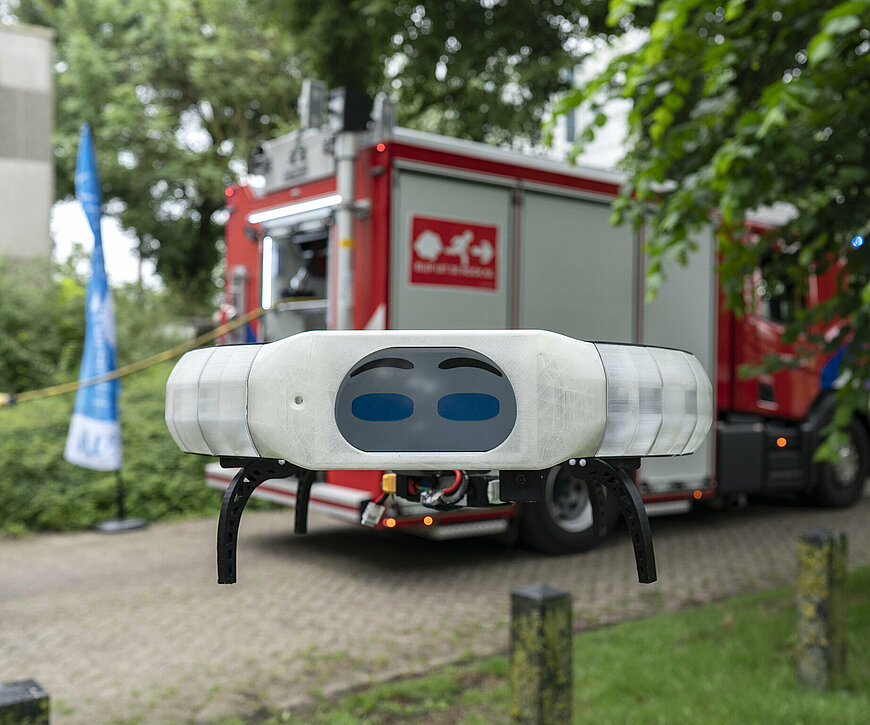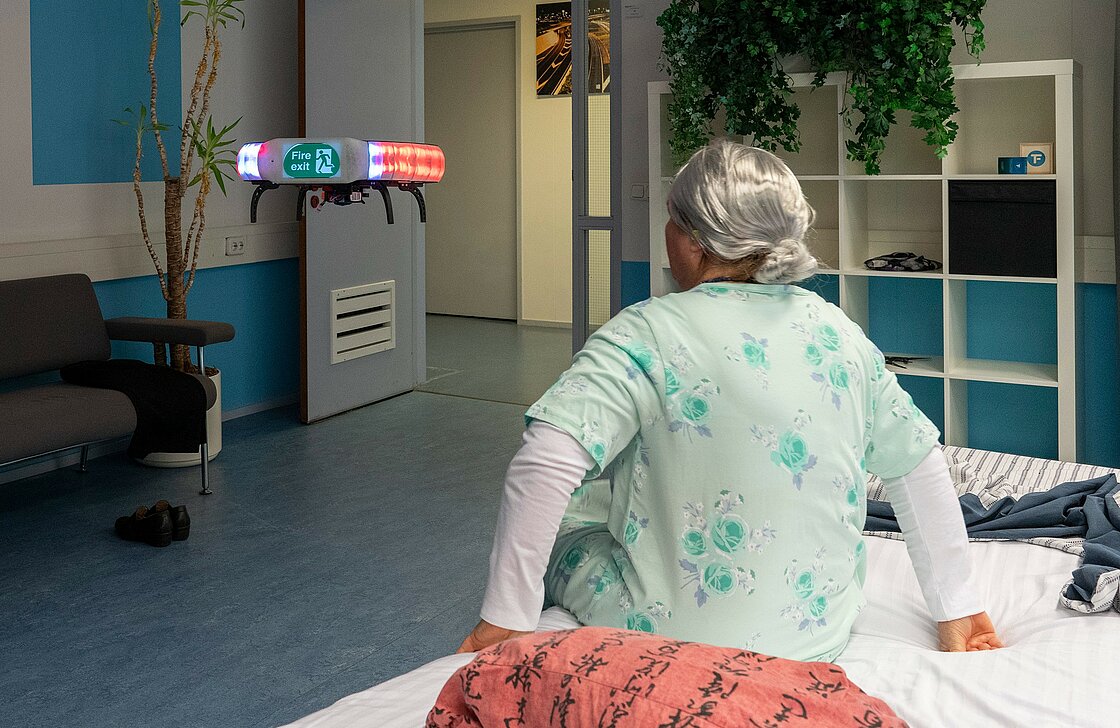Blue Jay drone lends a helping hand during a fire

A group of students from the Technical University of Eindhoven envisions developing a drone with added social value. The drone functions as an assistant for the fire brigade, which is especially useful and needed in elderly homes.
Last year, 22 people died in a fire in the Netherlands. Over sixty percent of these victims had an age over 65 according to the annual overview of fatal domestic fires in 2019. By detecting the fire in an early stage and assisting the residents and the fire brigade, Blue Jay can save lives! “An autonomous flying drone is an amazing opportunity to improve fire safety”, explains Paul van Dooren of the Dutch fire brigade. According to Paul, Blue Jay could protect the vulnerable elderly, “A son of an aged man in an elderly home gave his father an electric frying pan. However, the man put the pan on the stove. It caused a fire and the man passed away. Accidents like these could be prevented in the future by quick alarming of Blue Jay.”
Technology for good
On the 9th of July the team presented their proof of concept. In a real-life scenario, the drone assisted a resident of an elderly home during a fire. When a fire breaks out in an elderly home, it is protocol that all the personnel must wait outside until the fire brigade arrives. Due to this, crucial time is lost. By means of a heat sensor the drone detects the unsafe situation. With this knowledge the drone can determine a safe route for evacuation. Artificial intelligence is used to develop an algorithm detecting people, which is implemented in the drone. Blue Jay can also inspect the building looking for residents in danger. This information is shown to the fire brigade via an app. In this way, the approximate 7 minutes befor the fire brigade arrives will not be lost and be used to help residents out of their homes.
International and multi-disciplined
The Blue Jay team believes that drones and people can cooperate. The on-going project has the ultimate goal of developing an indoor drone that can assist in domestic and healthcare settings. The team consists every year of new ambitious students, setting aside their study to participate in the project. The current Blue Jay team consists of 17 students from the TU/e and Fontys with different majors and 4 different nationalities. To effectively work together the team is divided in multiple subteams. The Interaction Design subteam makes sure that the interaction between the drone and the user is optimized and that the needs of the user are satisfied. The hardware subteam is looking at aerodynamics, electrical efficiency and mechanics to ensure usability and flyability of the Blue Jay drone. Within the software team the challenge of autonomous flight is tackled and by means of AI multiple detection problems are solved. Every academic year an entirely different and new Blue Jay team starts. Continuity is assured through an advisory board that includes some of the previous year’s students who support the next year’s team. “In this way it is made sure that the long-term Blue Jay vision is ensured and that every team has its freedom for new insights and innovations.” explains Marieke Vermeulen, PR and finance manager of the team.


Collaboration equals innovation
“Blue Jay would not have been this far without our valuable partners” explains Anne Smits, team manager at Blue Jay Eindhoven. The network of Blue Jay has extended the last couple of years. Not only do the sponsors support the Blue Jay team with equipment and knowledge, but their experience and culture are also of great value to Blue Jay. The TU/e, NXP, Fourtress and Focus are the main project partners of the student team. At the 60th anniversary of the TU/e, a group of students was asked to develop an innovative technical product. The students came up with the world’s first Drone Café in which a drone prototype served drinks. After this event the students saw the potential of drones in our society. This was the start of the Blue Jay. However, the TU/e is not a main sponsor for this reason only. They support the team financially, with high-quality trainings (e.g. acquisition and project management) and a facility where they can work.
Mobile Robotics
NXP is helping the Blue Jay team by supplying Mobile Robotics technology for Flight Management Units, Companion co-processors and robust communication channels. NXP has a long history of delivering solutions for automotive and aerospace applications. Many of these solutions also apply to the rapidly evolving field of mobile robotics. Whether your system operates on the ground, under the sea or in the sky, NXP offers a complete portfolio of sensors, controllers and communications solutions. Therefore, NXP can provide a large part of the electronics Blue Jay needs as a starting point for their drone developments. For the AI part, Blue Jay was relying on a reference design called ‘Coral board’ combining the NXP i.MX8Q microprocessor and the Google’s Edge TPU.
Learning from each other
NXP and Blue Jay go back for 4 teams already. Former Blue Jay member, Jari van Ewijk, even took the opportunity to start as a working student at NXP in 2018 while continuing his electrical engineering study. Jari is still of great value for the team: “At the start of the academic year I organized a workshop for the Blue Jay team to get them quickly up and running” Also, the collaboration with Blue Jay is valuable for NXP. The student team is testing some of the new technologies and provide feedback on ease of use and performance. Next to that, a current Blue Jay member just started his NXP internship on companion processors and security. The current Blue Jay team has been facing extra difficulties due to the COVID-19 crisis. Their working office has been closed and they needed to work remotely. Jari joined them regularly during conference calls focusing on hardware and software to help them through this difficult period. “Even in these times, the team continued and prepared for their final event, which is remarkable.”
Valuable software and management knowledge
Fourtress develops unique and innovative software solutions for technical systems and with a focus on improving lives. From low level embedded software to hardware management, all the way to deploying middleware applications and the development of mobile apps. “We’ve been involved since the first Blue Jay team and we see it as a win-win. In the beginning we simply provided technical knowledge. But later we also loaned the team a software engineer for a few months and provided a student to work on the Blue Jay mobile app as a thesis project. This time we helped them improve their focus on the work that needs to be done. We provided support in setting up and configuring tools (Confluence & JIRA) in the Atlassian Cloud. This enabled them with an online team workspace for sharing knowledge and easier collaboration. Furthermore, it allowed them to plan, track and deliver new releases more efficiently. Since the beginning we see our cooperation as a win-win situation for both. We provide them in technical knowledge, the way of work and experience. But we also learn from them. We like their ambition, energetic way of work and enthusiastic environment. How we operate with Blue Jay is a bit of a model for how we try to operate with all our customers. In that, if you hire one Fourtress person, you hire all of Fourtress: all our knowledge is at your disposal. Together we go further!”
Flying autonomously
A crucial part of developing a drone that can assist the fire brigade, is that it needs to fly autonomously. Therefore, Blue Jay and Focus started collaborating. At Focus, a Vention spin-off, the Ultra-Wideband technology is developed. This technology enables both outdoor and indoor positioning. In the Ultra-Wideband system anchors are used that know their own location of which they are able to determine the location of what is tracked, so called ‘tags’. The Blue Jay drone is equipped with two tags to determine its location and direction. Niels Verstappen, software engineer at Blue Jay, “With Focus’ technology we are making indoor flight possible.”
Get in touch with the team if you’re interested in supporting their work, getting involved or becoming a partner. Send an email to:info@bluejayeindhoven.nl. If you want to support the team financially, visit the crowdfunding page: https://crowdfund.tue.nl/project/team-bluejay
A visual representation of Blue Jay’s work can be seen in this video: